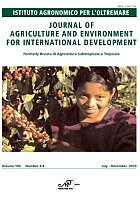Abstract
An irrigation plan for citrus fruit in the climatic context of the area studied seems possible on the basis of evaporation from a class A pan. In principle, a coefficient value of 0.6 could be retained.
Indeed, the use of this coefficient together with a high frequency of irrigation has made it possible not only to satisfy the water requirements of the citrus fruit, but also to obtain a good yield, namely 40 tons per hectare. In addition, it has been possible to achieve a great economy in water in comparison to the considerably larger quantities otherwise needed by many farmers. Hence, a great saving in water compared to quantities commonly bought by other farmers. This was reflected not only in the yield but also in the quality of the fruit, which turned out to be even better, as indicated by its size, since the quantity of water was closer to that needed. A poor yield was obtained when the water deficit was severe.





